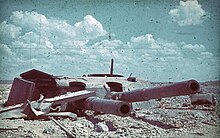| Armoured Coastal Batteries No.30 and No.35 | |
|---|---|
| Part of Soviet Union | |
| Crimea | |
 Maxim Gorky II in 1941 Maxim Gorky II in 1941 | |
| Type | Coastal defence and fortifications |
| Site information | |
| Controlled by | |
| Condition |
|
| Site history | |
| Built | 1912–1929 |
| In use |
|
| Battles/wars | World War II |
| Events | Crimean Campaign Siege of Sevastopol |
| Garrison information | |
| Past commanders |
|
| Occupants | Black Sea Fleet, Red Army |
Armoured Coastal Batteries #30 and #35, commonly known in English as Maxim Gorky I and Maxim Gorky II, were coastal batteries used by the Soviet Union during the Crimean Campaign of World War II. The invading German forces nicknamed them after the famous Soviet author and political activist Maxim Gorky.
Maxim Gorky I

Maxim Gorky I (Russian: Бронебашенная батарея-30, lit. 'Armoured Turret Battery-30') was located east of Ljabimorka, at 44°39′50″N 33°33′32″E / 44.664°N 33.559°E / 44.664; 33.559 (north of Severnaya Bay which formed Sevastopol's harbor), and contained two twin gun turrets which could fire four 30.5 cm guns. Once the Germans had broken through the Perekop Isthmus in October 1941, they advanced on Sevastopol but were confronted by Maxim Gorky I. They deployed the 80 cm rail gun Schwerer Gustav to destroy it. On June 6, 1942, heavy guns and Karl-Gerät siege mortars managed to make direct hits on the battery which destroyed one of the gun turrets and damaged the other. None of these were successful in eliminating the Maxim Gorky I, however, and it was not until June 17 that it was put out of action by German assault engineers. According to the Soviets, the batteries guns ran out of ammunition, firing was forced to cease, and the fortification was subsequently blown up by the crew.
Maxim Gorky II
Maxim Gorky II (Russian: Бронебашенная батарея-35, lit. 'Armoured Turret Battery-35'), which was armed with similar battleship turrets to Maxim Gorky I, was located on seaward cliffs on the southwest side of Sevastopol (44°33′32″N 33°24′25″E / 44.559°N 33.407°E / 44.559; 33.407. On July 4, Maxim Gorky II was taken after the Sapun positions were captured, making it the last major pre-war fortification to take part in a campaign.
Post-War

After the war, Maxim Gorky I was restored using the triple 305 mm gun turrets of the battleship Frunze, up-gunning it from 4 guns to 6, and upgraded with increased armour and a modern fire-control system. It remained in service until 1997 when it was mothballed, and the last time it fired its guns was in 1968, for the filming of the Soviet film "Sea on Fire" (Russian: Море в огне). It reportedly can be reactivated in only 72 hours.

Maxim Gorky II was not fully restored, with parts of the fort being used for other coastal batteries until 1963, when the military officially abandoned the fort. It was further damaged in the 1980s and 1990s by salvagers and grave robbers. In 2007, it was made into a museum complex commemorating the sacrifice of its defenders. Funding was acquired via charity, primarily from Russian businessman Aleksei Chaly.
Footnotes
- "...the first with twin gun turrets located east of Ljabimorka (north of the bay)..." Kuafmann, J. E. Fortress Europe: European fortifications of World War II Da Capo Press, p. 365.
- "...to the four giant 30.5 cm guns of the Maxim Gorky I coastal battery..." Weal, John. Ju 87 Stukageschwader of the Russian Front. Osprey Publishing, p. 34.
- "After the Germans overran the Perekop Line...the Germans deployed their super heavy artillery, including the 80cm rail gun Dora to destroy key points like Maxim Gorky I. On June 6, heavy German guns and mortars fired on Maxim Gorky I and scored direct hits that destroyed one of the turrets and damaged the other." Kuafmann, J. E. Fortress Europe: European fortifications of World War II Da Capo Press, p. 369.
- "Additional artillery fire and air bombardment failed to eliminate the Maxim Gorky damaged turret, which was finally put out of action by assault engineers on June 17."Kuafmann, J. E. Fortress Europe: European fortifications of World War II Da Capo Press, p. 369.
- "The Soviet version is that Coastal Battery 30 - its official designation - ceased firing simply because it had run out of ammunition, and was blown up by its crews." Weal, John. Ju 87 Stukageschwader of the Russian Front. Osprey Publishing, p. 36.
- "...the second with a set of similar turrets situated on the southwestern end of the peninsula where Sevastopol stood." Kuafmann, J. E. Fortress Europe: European fortifications of World War II Da Capo Press, p. 365.
- On July 4, after taking the Sapun positions, and the final assault that took Maxim Gorky II, the campaign against the last major pre-war fortified position came to a close." Kuafmann, J. E. Fortress Europe: European fortifications of World War II Da Capo Press, p. 369.
- "The History of Maxim Gorky-I Naval Battery, Sevastopol". Retrieved 2022-03-28.
- "Creation History". Retrieved 2022-03-28.
External links
Map all coordinates using OpenStreetMapDownload coordinates as:
Categories: